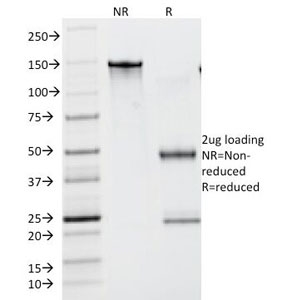Lambda Light Chain Antibody / Lambda Antibody
Overview
Antibody Isotype: Mouse IgG1, kappa
Antibody Clonality: Monoclonal
Applications:- Fluorescence-activated cell sorting (FACS)
- Immunofluorescence (IF)
- Immunohistochemistry- Paraffin Embedded (IHC-P)
- Western Blot (WB)
Store the Lambda Light Chain antibody at 2-8oC (with azide) or aliquot and store at -20oC or colder (without azide).
Images
1 / 2

2 / 2

Further Information
Flow cytometry: 0.5-1ug/million cells,Immunofluorescence: 1-2ug/ml,Western blot: 0.5-1ug/ml,Immunohistochemistry (FFPE): 0.5-1ug/ml for 30 min at RT
The optimal dilution of the Lambda Light Chain antibody for each application should be determined by the researcher.
Antibodies are produced by B lymphocytes, each expressing only one class of light chain. Once set, light chain class remains fixed for the life of the B lymphocyte. In a healthy individual, the total kappa to lambda ratio is roughly 3:1 in serum (measuring intact whole antibodies) or 1:1.5 if measuring free light chains, with a highly divergent ratio indicative of neoplasm.
Individual B-cells in lymphoid tissue possess either kappa or lambda light chains, but never both together. Specific rearrangement of lambda light chain of immunoglobulins can lead to loss of some protein coding genes, which does not seem to be functionally relevant (while functionally relevant miR-650 can be overexpressed). Using immunohistochemistry, it is possible to determine the relative abundance of B-cells expressing kappa and lambda light chains. If the lymph node or similar tissue is reactive, or otherwise benign, it should possess a mixture of kappa positive and lambda positive cells. If, however, one type of light chain is significantly more common than the other, the cells are likely all derived from a small clonal population, which may indicate a malignant condition, such as B-cell lymphoma. [Wiki]
Purified
0.2 mg/ml in 1X PBS with 0.1 mg/ml BSA (US sourced) and 0.05% sodium azide
IgG purified from human serum was used as the immunogen for this Lambda Light Chain antibody.
This Lambda Light Chain antibody is available for research use only.
Cell Surface, Cytoplasmic and Secreted
Protein G affinity chromatography
Human
P01701, P01842


